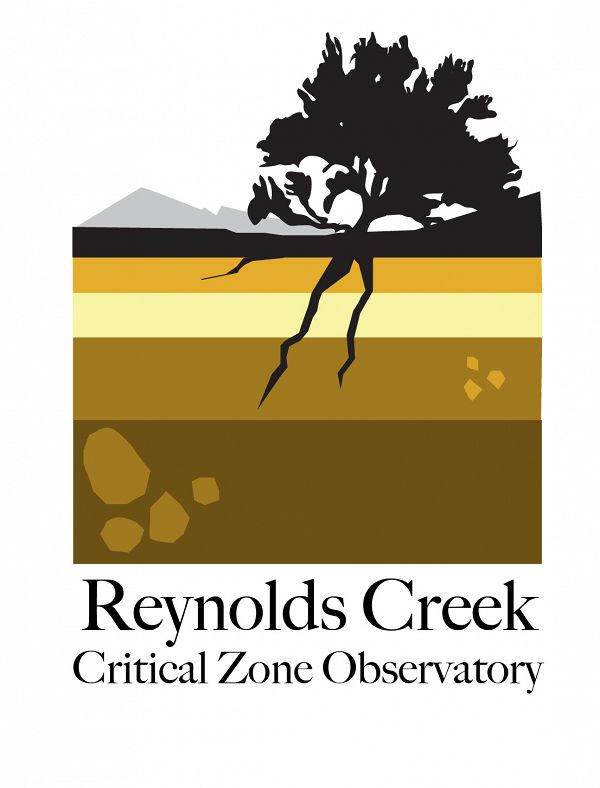Summary & Purpose
Long-term datasets of suspended sediment (SS) and particulate organic carbon (POC) are valuable to understand the role the fluvial export plays in the landscape responses to changing climate and disturbance regimes such as fire. Here we report a dataset that includes raw SS and POC concentrations and estimated long-term (> 23 years) SS and POC yields from 4 nested catchments that ranged from < 1 to 54 km2 in area across the Reynolds Creek Experimental Watershed and Critical Zone Observatory (RCEW-CZO) in southwestern Idaho, USA. We also estimated SS and POC yields from a burned catchment in the first two years following fire.
The RCEW-CZO is representative of many rangelands in the Intermountain West USA consisting of a mosaic of vegetation including Wyoming big sagebrush (Artemisia tridentata ssp. wyomingensis) and rabbitbrush (Chrysothamnus viscidiflorus) at lower elevations and mountain big sagebrush (Artemisia tridentata ssp. vaseyana), aspen (Populus tremuloides), bitter brush (Purshia tridentata), mountain mahogany (Cercocarpus ledifolius), Utah snowberry (Symphoricarpos oreophilus), and douglas-fir (Pseudotsuga menziesii) at higher elevation areas. Mean annual precipitation across these 4 catchments ranged from 616 to 911 mm yr-1 and mean annual temperature ranged from 7.16-4.75 degrees C.
We first developed relationships between SS and POC for the five catchments from two years of data, one dry and one of the wettest water years on record. We then estimated SS yields using a composite model in loadflex that performs residual correction to improve estimates with the exception of burned catchment where we used a linear interpolation. We found strong relationships between log-transformed SS and POC (R2=0.38-0.86) that varied across catchments but did not vary across years, one dry and one of the wettest water years on record. Mean annual SS yields varied from 18-89 g SS m-2 yr-1 and POC from 0.61-11 g C m-2 yr-1 across the four unburned catchments. SS and POC yields were 611 g SS m-2 yr-1 and 35 g C m-2 yr-1, respectively, from the burned catchment in the first year following fire, and yields remained elevated in the second year, at 466 g SS m-2 yr-1 and 27.5 g C m-2 yr-1, owing to the large water year. These datasets are unique because few long-term records are available across nested catchments in rangelands in the Intermountain West US, and these datasets will aid in modeling and understanding linkages between climate, erosion, and carbon.
Date of Publication or Submission
6-22-2021
DOI
https://doi.org/10.18122/reynoldscreek.25.boisestate
Funding Citation
This study was conducted in collaboration and cooperation with the USDA Agricultural Research Service, Northwest Watershed Research Center, Boise, Idaho, and landowners within the Reynolds Creek Experimental Watershed and Critical Zone Observatory (RCEW-CZO). Support for this research was provided by the National Science Foundation for RCEW-CZO Cooperative agreement, EAR-1331872. Any use of trade, firm, or product names is for descriptive purposes only and does not imply endorsement by the U.S. Government.
Single Dataset or Series?
Series
Data Format
*.xlsx
Data Attributes
See data dictionary located in Metadata sheet of each *.xlsx file.
Time Period
1994-2017
Use Restrictions
1. Use our data freely. All CZO, USGS, and USDA-ARS Data Products* except those labelled Private** are released to the public and may be freely copied, distributed, edited, remixed, and built upon under the condition that you give acknowledgement as described below. 2. Give proper acknowledgement. Publications, models and data products that make use of these datasets must include proper acknowledgement, including citing datasets in a similar way to citing a journal article (i.e. author, title, year of publication, name of CZO “publisher”, edition or version, and URL or DOI access information. See http://www.datacite.org/whycitedata). 3. Let us know how you will use the data. The dataset creators would appreciate hearing of any plans to use the dataset. Consider consultation or collaboration with dataset creators. *CZO Data Products. Defined as a data collected with any monetary or logistical support from a CZO.
Disclaimer of Warranty
BOISE STATE UNIVERSITY MAKES NO REPRESENTATIONS ABOUT THE SUITABILITY OF THE INFORMATION CONTAINED IN OR PROVIDED AS PART OF THE SYSTEM FOR ANY PURPOSE. ALL SUCH INFORMATION IS PROVIDED "AS IS" WITHOUT WARRANTY OF ANY KIND. BOISE STATE UNIVERSITY HEREBY DISCLAIMS ALL WARRANTIES AND CONDITIONS WITH REGARD TO THIS INFORMATION, INCLUDING ALL WARRANTIES AND CONDITIONS OF MERCHANTABILITY, WHETHER EXPRESS, IMPLIED OR STATUTORY, FITNESS FOR A PARTICULAR PURPOSE, TITLE AND NON-INFRINGEMENT.
IN NO EVENT SHALL BOISE STATE UNIVERSITY BE LIABLE FOR ANY SPECIAL, INDIRECT OR CONSEQUENTIAL DAMAGES OR ANY DAMAGES WHATSOEVER RESULTING FROM LOSS OF USE, DATA OR PROFITS, WHETHER IN AN ACTION OF CONTRACT, NEGLIGENCE OR OTHER TORTIOUS ACTION, ARISING OUT OF OR IN CONNECTION WITH THE USE OR PERFORMANCE OF INFORMATION AVAILABLE FROM THE SYSTEM.
THE INFORMATION PROVIDED BY THE SYSTEM COULD INCLUDE TECHNICAL INACCURACIES OR TYPOGRAPHICAL ERRORS. CHANGES ARE PERIODICALLY ADDED TO THE INFORMATION HEREIN. COMPANY AND/OR ITS RESPECTIVE SUPPLIERS MAY MAKE IMPROVEMENTS AND/OR CHANGES IN THE PRODUCT(S) AND/OR THE PROGRAM(S) DESCRIBED HEREIN AT ANY TIME, WITH OR WITHOUT NOTICE TO YOU.
BOISE STATE UNIVERSITY DOES NOT MAKE ANY ASSURANCES WITH REGARD TO THE ACCURACY OF THE RESULTS OR OUTPUT THAT DERIVES FROM USE OF THE SYSTEM.
Recommended Citation
Glossner, Kayla A.; Lohse, Kathleen A.; Appling, Alison P.; Cram, Zane K.; Murray, Erin; Godsey, Sarah; Van Vactor, Steven; Seyfried, Mark S.; and Pierson, Fred B.. (2021). Dataset of Observed Suspended Sediment and Particulate Organic Carbon Concentrations and Modeled Long-Term Suspended Sediment and Particulate Organic Carbon Yields (1994-2017) from the Reynolds Creek Experimental Watershed and Critical Zone Observatory in Southwestern Idaho, USA [Data set]. Retrieved from https://doi.org/10.18122/reynoldscreek.25.boisestate



Comments
Dataset Contributor: Emma McCorkle